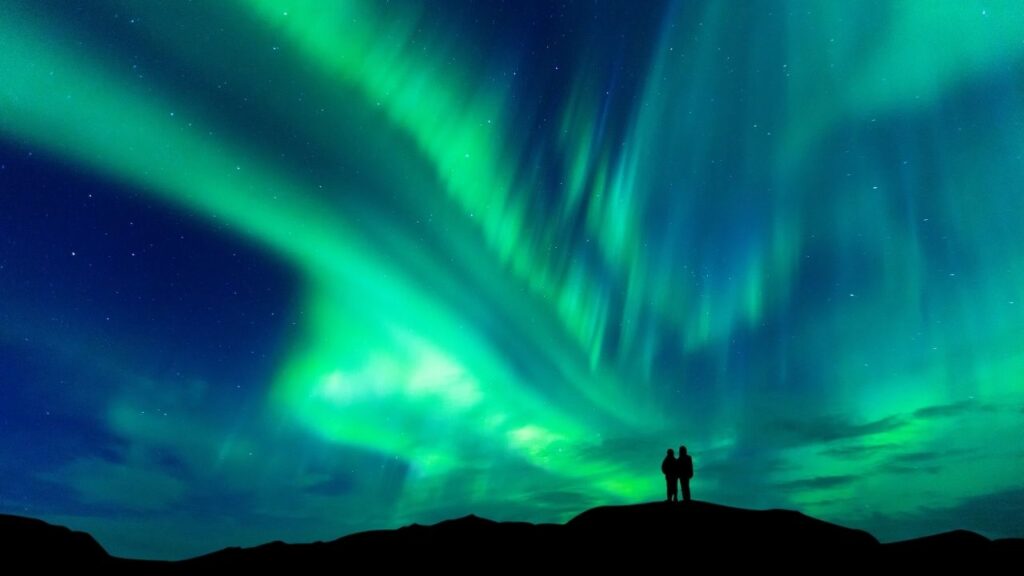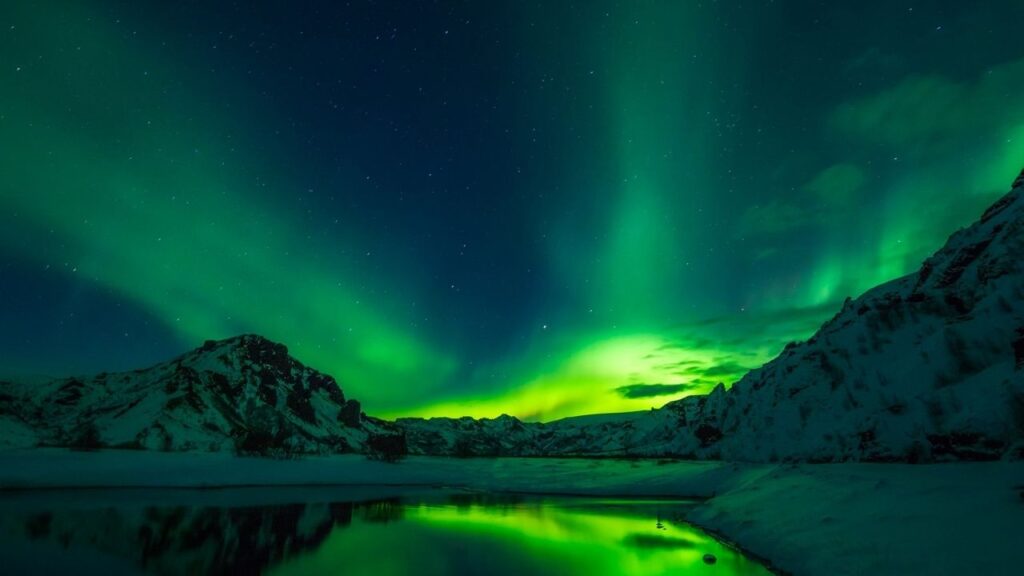Table of Contents
Best time to visit Iceland for Northern Lights
Best time to visit Iceland for Northern Lights: Iceland, the land of fire and ice, is a dream destination for adventurers and nature lovers. From its dramatic landscapes to its otherworldly natural phenomena, this Nordic island offers experiences that are truly once-in-a-lifetime.
Two of the most sought-after activities in Iceland are witnessing the Northern Lights and glacier hiking.
But when is the best time to visit Iceland to enjoy these incredible experiences? In this blog, we’ll dive into the ideal seasons, weather conditions, and tips for planning your trip to maximize your chances of seeing the auroras and exploring Iceland’s majestic glaciers.
Why Iceland is Perfect for Northern Lights and Glacier Hiking
Iceland’s unique geographical location makes it one of the best places in the world to see the Northern Lights.
Situated just below the Arctic Circle, the country offers dark, clear skies that are perfect for aurora viewing.
Additionally, Iceland is home to some of the most accessible glaciers in the world, including Vatnajökull, Europe’s largest glacier.
Glacier hiking here is not only thrilling but also offers a chance to explore ice caves, crevasses, and stunning glacial landscapes.
Whether you’re a solo traveler seeking solitude or an adventurer looking for your next challenge, Iceland’s combination of Northern Lights and glacier hiking makes it a must-visit destination.
But timing your trip right is key to making the most of these experiences.
The Best Time to See the Northern Lights in Iceland

The Aurora Season: September to March
Best time to visit Iceland for Northern Lights: The Northern Lights, or aurora borealis, are a natural phenomenon caused by solar particles interacting with Earth’s atmosphere.
To see them, you need dark skies, clear weather, and solar activity. In Iceland, the best time to see the Northern Lights is during the aurora season, which runs from late September to mid-March.
The peak months are typically October, November, February, and March. December and January also offer great opportunities, but the weather can be more unpredictable, with frequent snowstorms and cloud cover.
Tips for Northern Lights Viewing
To maximize your chances of seeing the Northern Lights, plan your trip during the aurora season and stay for at least a week to account for varying weather conditions.
Head to remote areas with minimal light pollution, such as Thingvellir National Park, the Snaefellsnes Peninsula, or the Westfjords.
Check the aurora forecast regularly and be patient—sometimes the lights appear late at night or in the early hours of the morning.
The Best Time for Glacier Hiking in Iceland
Summer Months: June to August
Glacier hiking is a year-round activity in Iceland, but the best time to do it is during the summer months, from June to August.
During this period, the weather is milder, and the days are long, with almost 24 hours of daylight in June.
This makes it easier and safer to explore the glaciers, as the conditions are more stable and the trails are more accessible.
Summer is also the best time to visit ice caves, which are formed by melting water flowing beneath the glaciers.
While some ice caves are accessible year-round, others are only safe to explore during the warmer months.
Shoulder Seasons: May and September
If you prefer fewer crowds and still want to enjoy glacier hiking, consider visiting during the shoulder seasons of May or September.
During these months, the weather is still relatively mild, and the glaciers are less crowded than in peak summer.
However, keep in mind that some ice caves may not be accessible, and the days are shorter compared to summer.
Combining Northern Lights and Glacier Hiking: When to Go
If you want to experience both the Northern Lights and glacier hiking during your trip to Iceland, the best time to visit is during the shoulder months of September and March.
During these months, you’ll have a good chance of seeing the auroras while still enjoying relatively stable weather for glacier hiking.
September: A Perfect Balance
September is an excellent time to visit Iceland for a combination of Northern Lights and glacier hiking.
The nights are dark enough for aurora viewing, and the weather is still mild enough for outdoor activities.
Additionally, the summer crowds have thinned out, making it easier to enjoy the glaciers without the hustle and bustle.
March: Winter’s Last Hurrah
March is another great option for combining these two experiences. The days are getting longer, and the weather is starting to warm up, making glacier hiking more comfortable.
At the same time, the nights are still dark enough for Northern Lights viewing. March also marks the end of the winter season, so you’ll have a chance to see snow-covered landscapes before they melt away.
What to Expect During Your Visit

Weather Conditions
Best time to visit Iceland for Northern Lights: Iceland’s weather is notoriously unpredictable, so it’s important to be prepared for all conditions.
During the Northern Lights season (September to March), temperatures can range from -10°C to 5°C (14°F to 41°F), with occasional snowstorms and strong winds.
In the summer months (June to August), temperatures are milder, ranging from 5°C to 15°C (41°F to 59°F), but rain and wind are still common.
Packing Essentials
No matter when you visit, packing the right gear is essential. For Northern Lights viewing, bring warm, layered clothing, a good-quality winter jacket, thermal gloves, and a hat.
For glacier hiking, sturdy hiking boots, waterproof clothing, and crampons (provided by tour operators) are a must. Don’t forget a camera to capture the stunning landscapes and auroras!
Tips for Planning Your Trip
Book Tours in Advance
Both Northern Lights tours and glacier hiking tours are popular activities in Iceland, so it’s a good idea to book in advance, especially if you’re visiting during peak seasons.
Many tour operators offer combined packages that include both activities, making it easier to plan your itinerary.
Stay Flexible
Iceland’s weather can be unpredictable, so it’s important to stay flexible with your plans. If a Northern Lights tour is canceled due to cloud cover, don’t worry—most operators offer a second chance on another night.
Similarly, glacier hiking tours may be rescheduled due to weather conditions, so allow some buffer time in your itinerary.
Explore Beyond the Golden Circle
While the Golden Circle is a popular tourist route, don’t limit yourself to just this area.
Iceland’s glaciers and Northern Lights can be seen in many parts of the country, including the south coast, the Snaefellsnes Peninsula, and the remote Westfjords.
Exploring these lesser-known areas will give you a more authentic and peaceful experience.
Final Thoughts

Best time to visit Iceland for Northern Lights: Iceland is a land of contrasts, where fire meets ice and darkness gives way to dazzling light.
Whether you’re chasing the Northern Lights or hiking across ancient glaciers, timing your visit right is key to making the most of your adventure.
For the best of both worlds, consider visiting during the shoulder months of September or March, when you can enjoy the magic of the auroras and the thrill of glacier hiking in one unforgettable trip.
So pack your warmest clothes, lace up your hiking boots, and get ready to explore the wonders of Iceland.
Whether you’re a solo traveler seeking solitude or an adventurer chasing new thrills, Iceland’s Northern Lights and glaciers promise an experience you’ll never forget. The adventure of a lifetime awaits.



